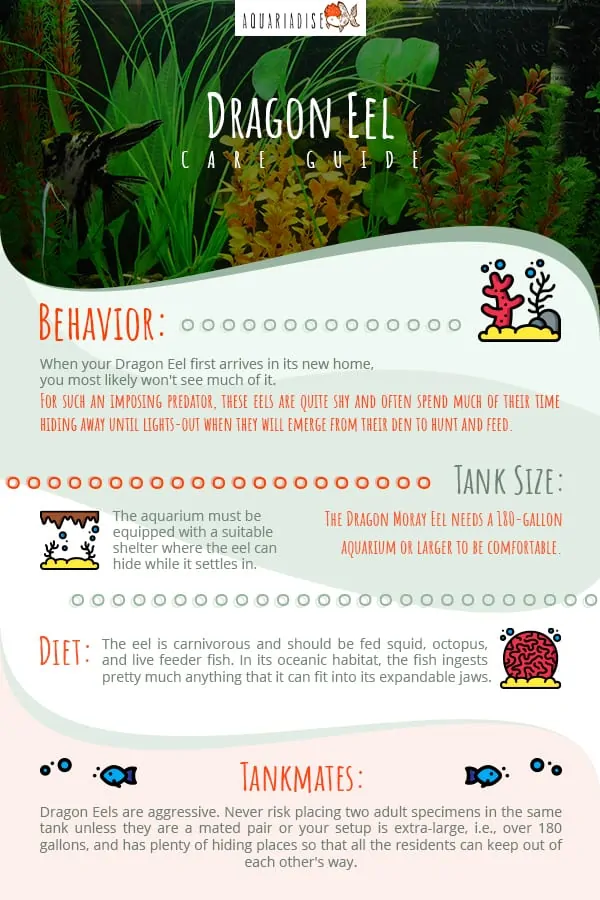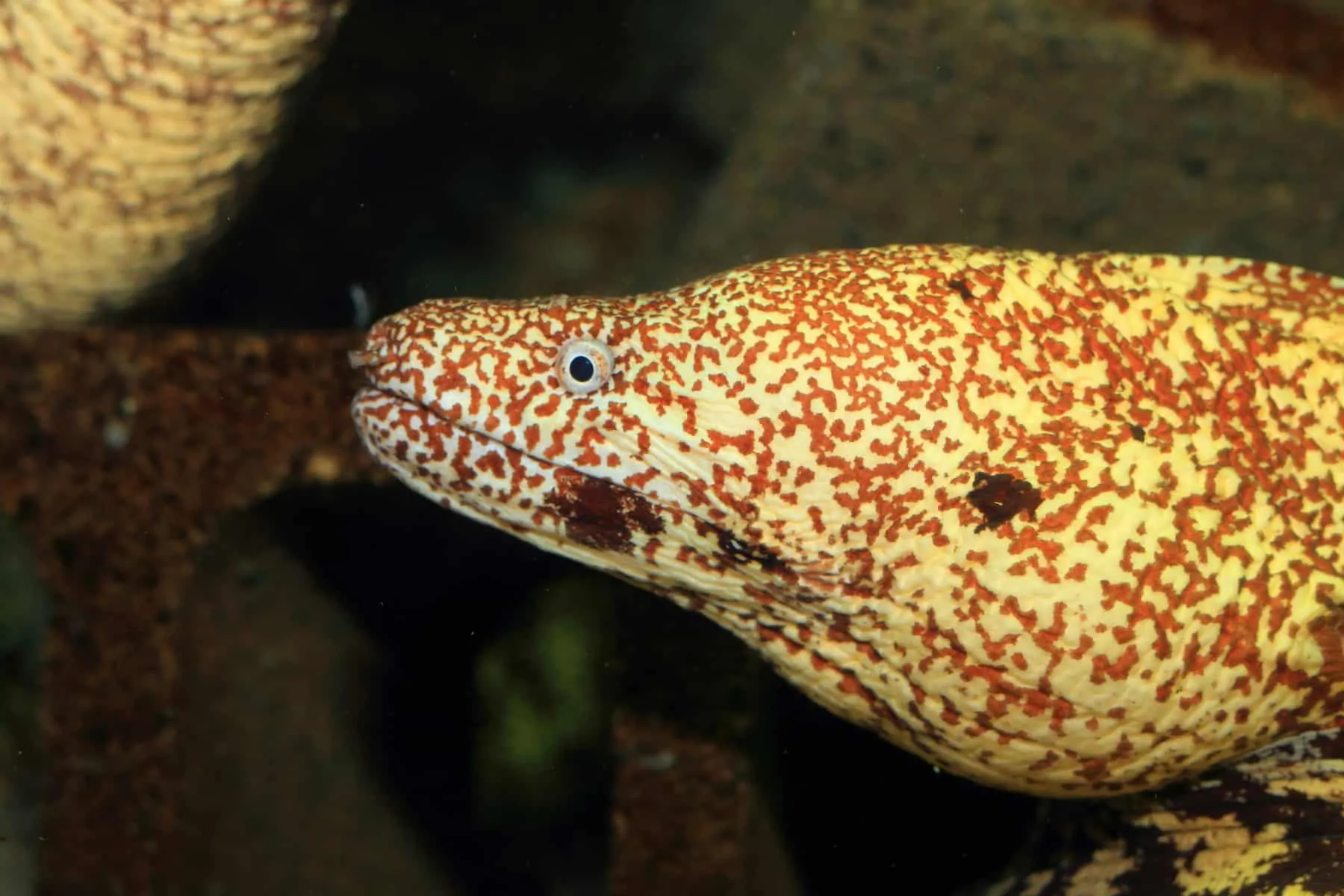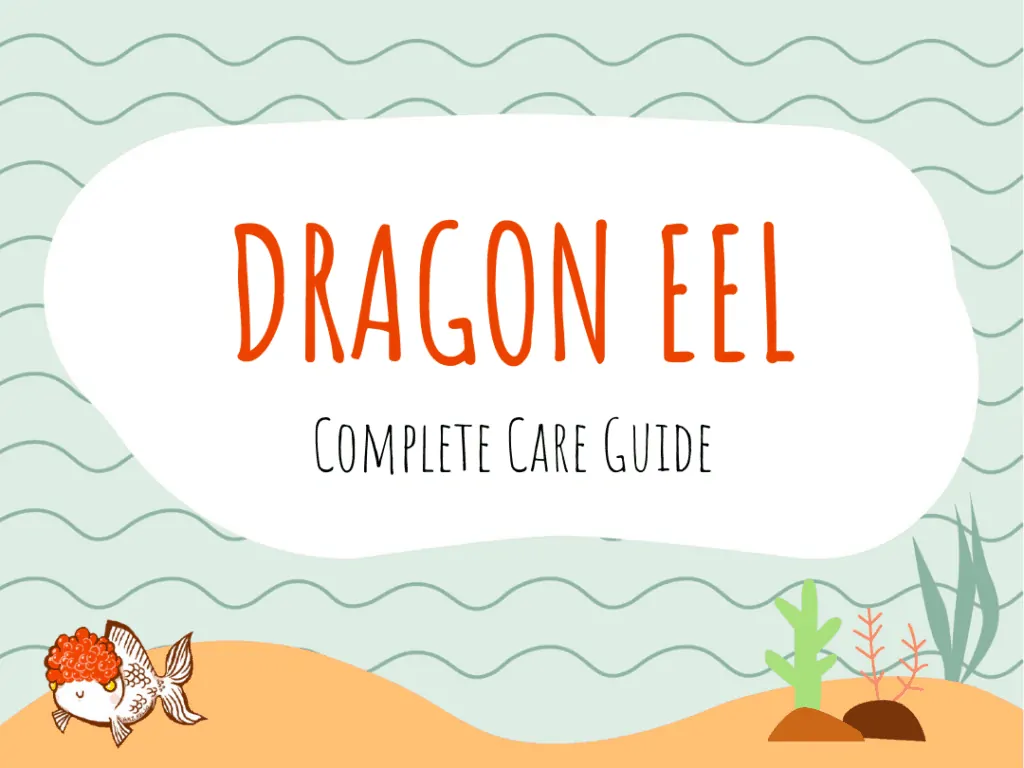If you have a very large marine aquarium and you’re looking to add a truly spectacular specimen to your collection, look no further than the Dragon Eel.
Here’s a guide to keeping this menacing-looking creature in your home tank. If you dare!

Enter the Dragon!
The Dragon Eel is a species of Moray that belongs to the Muraenidae family and has the scientific name, Enchelycore pardalis. The distinctive Dragon is easily recognized by its narrow curved jawline, vivid orange to red stripes on the head, and elongated nostrils that give the appearance of horns.
The Dragon Eel is found in the Indo-Pacific ocean, Southern Japan, and Hawaii. Although this stunning, predatory carnivore is not endangered, it is rarely seen, being mainly nocturnal and with the habit of hiding away in rocky crevices and outcrops and coral reefs
The Dragon Eel is also known by the following names:
- Dragon Moray Eel
- Dragonface Moray Eel
- Hawaiian Dragon Moray Eel
- Japanese Dragon Eel
The Dragon Moray is a bottom dweller that inhabits rock formations and caves, using them as cover for hunting, as well as for housing. The Japanese Dragon has a keen sense of smell that enables the animal to find its prey in the dark caves and inaccessible areas of their rocky territory.
Appearance
Dragon Morays have beautifully colored bodies with orange, black, yellow, red, and white patterning that runs the full length of the eel’s body.
Like all species of moray eel, the Dragon Moray has a huge, gaping mouth packed with sharp teeth, which, combined with spiked horns above the animal’s eyes, earned the creature its common name of Dragon Eel. Male and female Dragons do not differ in looks, although some experts say that the male of the species is more brightly colored.
It’s been suggested by some that the Japanese Dragon Eels are the most stunning variant of all, although the coloration of individual animals varies tremendously throughout populations.
Behavior
When your Dragon Eel first arrives in its new home, you most likely won’t see much of it. For such an imposing predator, these eels are quite shy and often spend much of their time hiding away until lights-out when they will emerge from their den to hunt and feed.
Once the eel is acclimated, it will sometimes lie out in plain view or spend much of its time with its head poking out of a rock cave or other hiding place.
The Dragon Eel has a spectacular threat display. The animal opens its jaws as widely as possible, flattens its gills, tilts its head to one side, and erects its dorsal fin. That display is usually enough to send all other tank occupants fleeing to safety!

Care of the Dragon Moray Eel
The Moray is an ocean-dwelling species that are difficult to keep in a home tank environment and ownership of one of these magnificent creatures is best left to experienced hobbyists who are familiar with their needs.
However, if you have a very large, established reef aquarium, one of these specimens makes a truly spectacular addition to your collection, as you can see from this YouTube clip, (Prado Jesus, rights reserved).
Tank conditions
The Dragon Moray Eel needs a 180-gallon aquarium or larger to be comfortable. The aquarium must be equipped with a suitable shelter where the eel can hide while it settles in. Eventually, you will be able to view the eel when it pokes is head out of its lair or lies out in full view.
The Dragon Moray is a bottom-dweller that can reach 36 inches in size when mature. For that reason, always house your eel in an aquarium that is long rather than tall. Although these creatures do not tend to swim around much, you should still have an aquarium that is a minimum of two feet from back to front to accommodate the rock structures and caves that make up the Dragon Moray’s habitat.
Note that the tank will need to have a tightly fitting lid to prevent the eel from escaping.
The Japanese Dragon is regarded as reef compatible in that they do not eat coral. However, the eels’ sheer size can make them destructive to reef tank habitats. Also, these animals will eat many of the smaller species that are typically included in reef tanks. For these reasons, we do not recommend including one of these specimens in a reef aquarium.
Water parameters
The Dragon Eel is an ocean-dweller and therefore requires a saltwater habitat.
These fish come regions where the water is temperate and should be provided with a water temperature of between 650 and 780 Fahrenheit. pH levels should be between 8.0 to 8.4, dKH 8 to 12, and salinity of 1.021 to 1.025.
Diet
The Dragon Moray Eel is carnivorous and should be fed squid, octopus, and live feeder fish.
In its wild oceanic habitat, the Dragon Moray eats fish, ingesting pretty much anything that it can fit into its expandable jaws. Some larger eels have been seen biting and mutilating fish that are too large for the eel to swallow whole. Tankmates must, therefore, be chosen carefully, as they may be predated on by your Moray Eel.
Once the eel has become acclimated, you should start feeding it long strips of raw fish, such as smelt, haddock, squid, and the like. Spear the food on a set of feeding tongs and tempt the eel into eating by waving the piece of fish in front of the Moray’s head so that it can smell the food.
Feeding frequency
The Japanese Dragon Eel can take some time to settle into an aquarium setting. So, don’t be alarmed if your new purchase doesn’t want to eat at first; it’s not unusual for these creatures to go for weeks or even months without eating anything. Under these circumstances, it’s best to offer your eel live shrimp or feeder fish, and keep the lighting low to replicate the animal’s natural nocturnal feeding habit.
It’s very important not to feed your Dragon Moray too often, as overfeeding can lead to fatty infiltration of the eel’s liver, which can cause liver disease. Studies have shown that Morays are infrequent eaters, so it’s best to feed your specimen just twice a week, offering it just what it will eat in a couple of minutes.
Also, overfeeding can result in the eel regurgitating partially digested food, making a real mess in your tank. If your eel refuses to eat, it may be because it is overfed, the water quality in the aquarium has deteriorated, or the water temperature has dropped abruptly.
Try carrying out a partial water change, offering a different type of food, or just being patient.
Take great care when feeding your specific Eel. These impressive creatures have poor eyesight that is compensated for by their super-keen sense of smell. That can result in an accidental bite if you are hand-feeding your specimen. For that reason, we recommend that you use metal feeding tongs rather than using your fingers.
An eel’s bite can cause a serious bacterial infection. If you are bitten, always be sure to thoroughly clean and disinfect the wound and see your doctor if the area is itchy, swollen, reddened, or painful.
Tankmates
Dragon Eels are aggressive. Never risk placing two adult specimens in the same tank unless they are a mated pair or your setup is extra-large, i.e., over 180 gallons, and has plenty of hiding places so that all the residents can keep out of each other’s way.
That said, juveniles of the species can live with other eels, although adults may attack them, especially if other Morays arrive subsequently. Also, make sure that all the eels are of a similar size or slightly larger than the Dragon.
If you have an aquarium of over 200 gallons, there are some fish that you could include as tankmates for your Japanese Dragon Eel. These guys can all take care of themselves and should be left in peace, providing you with an impressive and relatively peaceful display:
- Triggerfish
- Groupers
- Snappers
- Lionfish
- Puffers
Other similar large species may also be considered.
Health
These animals are pretty hardy once they’ve settled into their new home. As long as you have an efficient filtration system and the water quality is good, the Moray is one of the most disease-resistant marines you can keep.
That said, Morays have scaleless skin, making them vulnerable to copper-based treatments. So, although these creatures rarely suffer from parasitic diseases, always use a copper-free medication when necessary.
Sometimes, bacterial infections can occur, usually following trauma during shipping or handling, or if the water quality is poor. However, Morays do respond well to antibiotics.
When choosing your Dragon, always try to carry out an inspection of the whole eel. That may mean that you’ll need to ask the dealer to tempt the creature out of its den in the holding tank. Look out for any obvious physical damage, as well as cloudy eyes. Always quarantine your eel, as you would for any new specimen, before adding it to your setup.
Breeding
As yet, it is not possible to breed any of the Moray species in captivity.
That’s because of the young elvers’ planktonic larval stage (leptocephalus) during which the juvenile eels drift on the oceanic currents for months until morphing into recognizable young eels. As yet, it has simply proven impossible to replicate those conditions in captivity. So, all Moray eels that are for sale come straight from their natural habitat to the dealer.
Availability
Enchelycore pardalis is not readily available in your local fish store, although you may be able to order one from a specialist saltwater species dealer.
You should expect to pay upwards of $800 for an immature 12-inch specimen and anything up to $2,000 for an eel that’s closer to its mature size. Remember that you’re likely to incur shipping costs on top of that amount, especially if you order from a .com site. Many suppliers and aquatic specialists ask that you email them to check what stock they have available before you place an order.
If you order from a .com supplier, please choose a U.S. supplier, even if that means waiting a while for a suitable eel to become available. That will not only help to keep shipping costs down but should also ensure that your purchase arrives alive and well.
FAQ
In this part of our guide, we answer a few of the most frequently asked questions that potential purchasers have for suppliers. Armed with this information, you’ll be in a better position to decide whether one of these spectacular predators is really for you.
Q: How much does a dragon eel cost?
A: Dragon Eels can cost upward of $800, depending on the size and age of the specimen, location of the supplier, and shipping costs.
Q: How big do dragon eels get?
A: These creatures can grow to measure 36 inches in length when mature. However, younger animals, measuring around 12 inches long, are often found for sale at a lower price than you’ll pay for a really big one.
Q: Where do dragon eels live?
A: Dragon eels are ocean dwellers, inhabiting reefs, and rocky areas where the environment suits their covert hunting technique, and prey is plentiful. These animals can be found in good numbers in Southern Japan, Hawaii, and the Indo-Pacific.
Q: How much does a moray eel cost?
A: Moray eels can cost up to $1,200, starting at around $800 for an immature specimen. You can order online from a specialist .com supplier. Email first to confirm availability or place an order.
Final thoughts
The Japanese Dragon Eel is a brightly colored, aggressive saltwater predator that would make a stunning addition to any display aquarium. However, taking on one of these beasts is not the best idea for the novice hobbyist, being expensive to buy, incompatible with most tankmates, and tricky to keep.
If you have a very large reef aquarium that contains a variety of large, semi-aggressive fishes and suitable rocky habitat, and you have plenty of cash to spend, you might want to take on a Dragon.



I’ve had my Dragon Eel @ 2 years in a 400g tank and is 36″ long. When hungry will eat 2-3 silversides daily for 3 weeks then won’t eat for a month which I understand is not an unusual length of time. But from your diet info I didn’t realize that this may be too much food feeding?
Right now I’ve noticed that the right circular gill doesn’t always open/close and all the breathing is done from the left circular gill. Currently the eel doesn’t appear to be as strong and is lethargic. Is this normal ?
I’m worried that something isn’t right.
Hey Ken,
You can feed your fish as often as it will eat as long as it doesn’t affect water parameters or the livelihood of your fish. I am willing to bet that something else is wrong first, instead of diet. Test water parameters and check for other signs of disease.